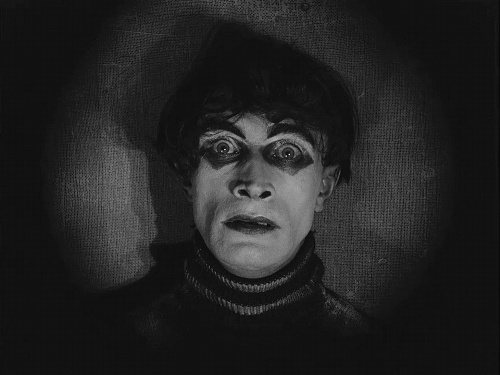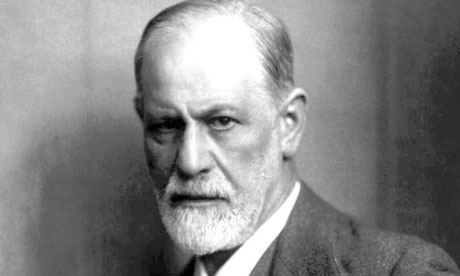The Cabinet of Dr. Caligari (1920)
Fig 1: poster
The Cabinet of Dr. Caligari (Robert Wiene) dives into the psyche of Francis (Friedrich Fehér). At first the film appears to tell the story of identical murders by a sinister serial killer. It is later revealed that Francis is psychotic, and the story is actually his delusions of the people around him. I found this film interesting not just for the abstract shapes and the use of colour, but for the way it psychoanalyzes the mind of a psycho.
The first scene gave the spectator a small chance to see how Francis's mind works, this is why nothing actually made sense other than his story telling. There is a scene in which the murderer kills Francis's friend, this was one of my favorite scenes because i noticed the use of a technique which is still used in modern cinema. known to some as the enigma, it hides the identity of the killer until the big reveal. The enigma helps some deaths look more graphic, like the silhouettes of someone being stabbed, or the shower scene from psycho ( Alfred Hitchcock, 1960). I like the idea of a mysterious murderer because it allow me as the spectator to use my imagination. the best example of forced imagination use is in David Finchers Seven (1995) when mills sees content of a box. The spectator does not know what is in the box , but we rationalize it and imagine the worst thing possible. I like this technique because although it might be a head to me. it could also be a hand with a ring or something else that could trigger the character's emotional response. Although the film are not be directly linked i do believe they are linked in some way, because of the way they extract emotion form the spectator.
Fig 2: Cesare
Throughout the film a fish eye effect is used to help convey emotion. it focuses on just the faces of characters to show their expressions and their emotions. I found that the fish eye shot is also used as a smoother transition which made the film easier to watch. The continuity in the the film felt disjointed and lost, which is explained to the spectator when they find out they are in the mind of a psycho. I found the bizarre nature of the film interesting as it felt new and unpredictable, I enjoyed seeing the way the film twisted todorovian narrative to create narrative filled with disequilibrium and dis-junction.
Fig 3: City
I enjoyed the establishing shots because they show the abstract buildings and the strange cityscape, I also thought the use of abstract buildings was ingenious as it shows Francis's mind. The Film uses a technique called film tinting to create a day and night cycle, i believe that this helps give the films a sense of progression. The architecture of the buildings is interesting, every building was different when you also take into account Francis's psyche his mind appears unique. The city shows his lack of control and how dangerous he is to himself and other. each set looked like a completely different location, the image above reminds me of Gotham City, whereas the image below reminds me ofla strada (Federico Fellini, 1954), which shows me that movements like neo-realism could have be inspired by The Cabinet of Dr. Caligari. Roger Bert said "The visual environment plays like a wilderness of blades," I found this point interesting as it reinforces the idea that Francis is dangerous.
Fig 4: Circus
Although the film is sepia I noticed that lighting was used to change the mood of most scenes. A good example of this is at the police station, the scene is brighter which creates a sense of security. When Cersare is introduced the scene is black and white instead of sepia, this makes him seem menacing and establishes him as a villain. The score adds to tension built up by lighting in some scenes, I found myself not noticing the score when nothing was happening, but as soon as something unexpected happens it becomes loud, screechy and unbearable.
Fig 5: Freud
While watching the film I could not help but notice the references to Freud's ego theory. Francis is suffering from Four of Freud's ego defense mechanisms. from what i saw in the film Francis was projecting all of the qualities of himself that he did not like onto Dr. Caligari, for example his insanity. In the story that he told Dr. Caligari was crazy and inhumane, which was not true in real life. Denial is the rejection of reality, Francis shows he is in denial when he shouts "you all think i'm insane that's not true." displacement is taking out impulses on weaker target whether that be mentally or physically. I noticed that Francis displaced his emotions on Cesare another mental patient, This might be because he believed that Cesare was mentally weaker than him, so he was an easier target. This explains why in Francis's story Cesare is a sleepwalker/puppet, he is not mentally strong enough to wake up or move at will. Francis rationalizes why he is in a mental home by creating a world in which he is sane. he believes that he was tricked by Caligari and the mental home was a way of silencing him.
In conclusion I enjoyed this film, I believe that the method s its used to extract emotions pioneered techniques used in modern films. although i didn't really see it as a horror film because of my desensitization to the genre, I do understand why it is seen as the first true horror film.
Image List
Fig 1 poster-http://cdn8.openculture.com/wp-content/uploads/2013/10/Cabinet-Of-Dr.-Caligari-.jpghttps://33.media.tumblr.com/b412d664c27dcdafe344e701ca2e5b6e/tumblr_nbg9hxW2pU1qlny4mo4_500.png
Fig 2 Cesare-https://lightsmellsloud.files.wordpress.com/2013/05/screenshot1.jpg
Fig 3 city-http://ic.pics.livejournal.com/greyweirdo/3384090/273256/273256_original.jpg
Fig 4 circus-http://allpsych.com/psychology101/defenses.html
Fig 5 Freud-http://curiosidades.batanga.com/sites/curiosidades.batanga.com/files/Grandes-cientificos-Sigmund-Freud-4.jpg
Bibliography
http://www.rogerebert.com/reviews/great-movie-the-cabinet-of-dr-caligari-1920(Accessed on 24/09/14)
http://allpsych.com/psychology101/defenses.html (Accessed on 24/09/14)







Hi Ryan,
ReplyDeleteGood work getting your first review out there sharpish :)
You have made some really interesting observations on the use of colour and set, and it's encouraging to see you linking in theoretical ideas, such as Freud's, at such an early stage - well done!
Just a couple of general pointers... have a look at the guide that Phil has made available both on the group blog and myUCA, for hints on writing in the 3rd person. At the moment, you are using 'I' an awful lot, and this gives your piece a more chatty, and less academic voice. It will probably feel a bit strange and alien to be writing in this way to start with but it's a good habit to get into from the off, and will really lift standard of your work :)
Make sure that you use 3 quotes to support your writing, and that they are referenced correctly. You have made a good choice with the quote by Roger Ebert, and have introduced it and gone some way to 'unpick' it afterwards... you need to ensure that the quote itself is in italics, and has the surname and the date after it in brackets, so for example (Ebert, 2009). You are also missing some of the information in the bibliography, so I will point you to the referencing guide that is available on myUCA, here - http://community.ucreative.ac.uk/Harvard-Referencing
Looking forward to your next review!
Well done, Ryan :) your debut as a film critic is done and dusted. Just a small additional note - consider using a larger text size to improve the readability of your review and also avoid centralising your text (it makes it look like a song or poem). Instead use the justify option (that's the option that isn't align left, align right or centre). It will give your reviews a more book-like appearance.
ReplyDelete